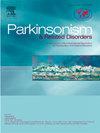中国儿科患者KMT2B变异的临床表现及发病机制
IF 3.1
3区 医学
Q2 CLINICAL NEUROLOGY
引用次数: 0
摘要
方法 我们报告了来自中国一个中心的27例(男14例,女13例)通过新一代测序鉴定出KMT2B变体的儿科患者,并对不同基因型患者的成纤维细胞进行了转录组学和蛋白质组学检测。结果26例患者患有肌张力障碍,包括全身性肌张力障碍(19例)、多灶性肌张力障碍(6例)和节段性肌张力障碍(1例),1例患者患有非肌张力障碍性重度发育迟缓(DD)。所有26名患者都患有复杂肌张力障碍,并伴有其他运动障碍表现(震颤(6例)、肌阵挛(5例)、肌张力障碍(2例)和抽搐(1例))或畸形特征和发育迟缓。肌张力障碍的发病年龄为 1 个月至 13 岁 8 个月(中位数为 4 岁 4 个月)。肌张力障碍会因发热(11 例)、昼夜和气候波动(4 例)而加重。11 名患者接受了脑深部刺激治疗,其运动功能和残疾状况得到了显著改善。我们发现了 26 个基因内杂合子 KMT2B 致病变异和一个 Chr:19q13.12 连续基因缺失。其中 16 个变体为新变体。在患者成纤维细胞中,KMT2B变体诱导的差异表达基因明显富集于线粒体相关的生物过程。结论:我们的研究报告了来自中国一个中心的 KMT2B 相关疾病的儿科病例。此外,我们的研究还强调了 KMT2B 变体在线粒体功能障碍中的作用。本文章由计算机程序翻译,如有差异,请以英文原文为准。
The clinical spectrum and pathogenesis associated with KMT2B variants in Chinese pediatric patients
Objective
To evaluate the clinical spectrum and pathogenesis associated with KMT2B variants in Chinese children with dystonia or developmental delay.
Methods
We reported twenty-seven (fourteen males and thirteen females) pediatric patients with KMT2B variants identified via next-generation sequencing from a single Chinese center. Moreover, transcriptomics and proteomics assays were performed on fibroblasts from patients with different genotypes to investigate the pathogenic mechanisms involved.
Results
Twenty-six patients had dystonia including generalized dystonia (n = 19), multifocal dystonia (n = 6), and segmental dystonia (n = 1), and one patient had nondystonic severe-developmental delay (DD). All the twenty-six patients had complex dystonia compounded with other manifestations of movement disorders (tremor (n = 6), myoclonus (n = 5), status dystonicus (n = 2), and tic (n = 1)) or dysmorphic features and developmental delay. The onset of dystonia was between 1 month and 13 years 8 months (median 4 years 4 months). Dystonia was aggravated by fever (n = 11), and diurnal and climate fluctuations (n = 4). Eleven patients underwent deep brain stimulation and experienced significant improvements in motor function and disability. We identified twenty-six intragenic heterozygous KMT2B pathogenic variants and one Chr:19q13.12 contiguous gene deletion. Sixteen variants were novel. Differentially expressed genes induced by KMT2B variants were significantly enriched for mitochondria-related biological processes in patient fibroblasts. As a result, mitochondrial morphology of mitochondria was altered, and aerobic respiration was impaired.
Conclusion
Our study reports the pediatric cases of KMT2B-related disorder from a single center in China. Additionally, our study highlights the role of KMT2B variants in mitochondrial dysfunction.
求助全文
通过发布文献求助,成功后即可免费获取论文全文。
去求助
来源期刊

Parkinsonism & related disorders
医学-临床神经学
CiteScore
6.20
自引率
4.90%
发文量
292
审稿时长
39 days
期刊介绍:
Parkinsonism & Related Disorders publishes the results of basic and clinical research contributing to the understanding, diagnosis and treatment of all neurodegenerative syndromes in which Parkinsonism, Essential Tremor or related movement disorders may be a feature. Regular features will include: Review Articles, Point of View articles, Full-length Articles, Short Communications, Case Reports and Letter to the Editor.
 求助内容:
求助内容: 应助结果提醒方式:
应助结果提醒方式:


